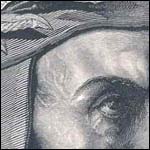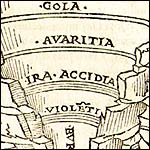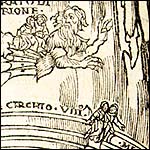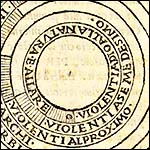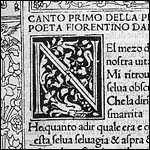Dante Alighieri was born in May or June 1265 in Florence, Italy. By the age of nine, Dante met the girl who would become the focus of his creativity for the rest of his life. At that age, Dante first encountered Beatrice Portinari, who remained his Muse even after her death in 1290. His parents were of low aristocracy and a member of the Guelf political party. Since the early thirteenth century, the political parties of the Guelfi and the Ghibellini competed for control of Florence. The Guelfi favored the Pope as the leader of Italy, while the Ghibellini favored the emperor. Toward the end of the thirteenth century, the Guelfi had broken into factions, the Blacks, who were committed to the interests of the Vatican, and the Whites, who were more moderate in their stance. Dante’s family was White Guelfs.
Dante’s education made him one of the most intellectual nonprofessionals of his era. His first schooling was in rhetoric, grammar, philosophy, literature, and theology. During his twenties, Dante was intrigued by the new poetical movement that he termed the dolce stil novo. This poetry emphasized love through feelings and psychology; love is an absolute ideal because it is able to ennoble and save man. Women are seen as angels, and are often celebrated as examples of purity and virtue. Dante was one of the most famous of the stil novo poetical school and had many friends among the other members. After the death of Beatrice in 1290, Dante began to study philosophy seriously, including Aristotle and St. Thomas Aquinas. Dante's love of philosophy cannot be studied separately from his life as a writer -- as a poet whose theme, from first to last is the significance of his love for Beatrice, but also as an intellectual strongly committed to raising the level of public discourse.
In 1285 Dante married Gemma di Manetto Donati, and the couple had three or four children. Dante joined a Medical Corporation in 1295, hoping to begin a political career. He was appointed as a priore, a type of governor, within five years. Around that time, battles between the White and Black Guelfs became intense, and the Pope issued a statement that allowed the Blacks to exile the Whites. Dante was exiled and never returned to Florence, although he stayed interested in Italian politics. After this period, Dante roamed Italy through Verona, Tuscany, and Ravenna. He died in Ravenna in 1321 and was buried in San Pier Maggiore’s Church, now called San Francesco’s, where his tomb is still located.
greatdante.net. "Dante Alighieri on the Web," available from http://www.greatdante.net/; Internet; accessed 3 December 2004. |
Stanford Encyclopedia of Philosophy. "Dante Alighieri ," available from http://plato.stanford.edu/entries/dante/; Internet; accessed 29 September 2005. |



